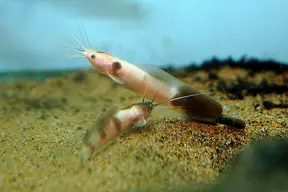Clarias batrachus
Walking Catfish
Classification
Clariidae
Distribution
Knwon from India, Nepal, Bangladesh, Sri Lanka, Pakistan, Thailand, Vietnam, Laos, Cambodia, Myanmar, Singapore, Malaysia and Indonesia. It has also been introduced in several countries, including the USA.
Habitat
Inhabits river systems, swamps, pools, rice paddies, canals and ditches. It’s often found in stagnant waters left over after the rivers have been in flood, as it’s migratory during the wet season, moving into flooded areas from the main water bodies.
Maximum Standard Length
40″ (100cm). However this is rarely achieved in captivity, with 18-24″ (45-60cm) being considered a good size.
Aquarium SizeTop ↑
84″ x 48″ x 36″ (210cm x 120cm x 90cm) – 2300 litres for a fully grown adult specimen. Juveniles can be grown on in smaller tanks.
Maintenance
Floor space is more important than depth with this species. A soft substrate with pieces of driftwood , smooth rocks, lengths of plastic piping etc. arranged to form hiding places is ideal. Plants are not essential. The aquarium should have a very tight-fitting cover, as it’s an excellent escape artist.
Water Conditions
Temperature: 68-78°F (20-26°C)
pH: 5.5-8.0
Hardness: 2-25°H
Diet
A greedy and omnivorous species that will eat almost anything offered. A varied mixture of dried pellets, meaty frozen foods and vegetable matter is recommended. Adult specimens do not need to be fed every day. Take care when feeding as this is one fish that just doesn’t know when to stop eating!
Behaviour and CompatibilityTop ↑
C. batrachus is highly predatory and will eat any fish it can fit into its large mouth. It can be kept with other similarly-sized, robust species, such as large barbs, Loricariids and cichlids. Any tankmates must be able to take good care of themselves and should be introduced at a larger size than the Clarias, as the growth rate of young fish is phenomenal. Definitely not a fish for the general community.
Sexual Dimorphism
In the wild form, male fish show spotting in the dorsal fin. This distinction cannot be made for the aquarium varieties, but sexing can be determined by examining the genital papillae of the fish. This is elongate and pointed in the male, and shorter and blunted in the female. Female fish are also much more rounded in the belly than males.
Reproduction
Has been achieved in huge numbers on fish farms throughout the world, but occurs less often in aquaria. It is possible in a suitably sized aquarium, though. The fish appear to be sexually mature from around 12″ (30cm) in size. It may be wise to begin with a small group of young fish in order to obtain a pair, unless a sexed pair is available. Once a pair forms they become territorial and the other Clarias and any other tankmates should be removed. Water chemistry and temperature is not critical, but should be within the boundaries suggested above.
Prior to spawning body contact between the pair increases and they can be observed swimming side-by-side. In nature the fish spawn in caves dug into the banks of rivers, but if no such cave is available in the aquarium they will dig a pit in the substrate and deposit the eggs into this. The event itself can last as long as 20 hours, with the pair coming together many times above the spawning site. Many eggs are laid (several thousand may be produced by large pairs) and these sink immediately, adhering to the substrate where they fall.
Following spawning, the female retreats and the male assumes protection of the brood, swimming tirelessly above the nest in anticipation of potential predators. It may also be that the currents produced by his unceasing movements assist in the development of the eggs. The eggs hatch in 24-36 hours, at which point the female again begins to assist in brood care, assuming responsibility for guarding the perimeters of the territory. The male remains at the nest. After around another 48 hours, the adults begin to lose interest in the fry. 72 hours after this, the young become free swimming. At this point, it is wise to remove the fry with the aid of a syphon, if you intend raising them in any great numbers. They can be fed brine shrimp nauplii initially, but grow rapidly and are soon large enough to take bigger foods.
NotesTop ↑
An incredibly hardy species, the walking catfish is tolerant of a very wide range of water chemistry and temperature. It can also survive in oxygen-depleted conditions due to its ability to breathe atmospheric air. In fact, it is thought that the fish can literally drown if deprived access to the water surface for long enough.
The common name is derived from its natural ability to move across land using its stiff pectoral spines, provided it stays damp. It has special mucous-producing pores on its body to help in this, and it can seal its gills to prevent loss of moisture. The gills themselves are stiffened in order to prevent them collapsing outside the water. This is why a tightly fitting cover is absolutely essential on any aquarium containing a walking cat, as it’s quite willing to leave the aquarium for a “wander” if the opportunity arises.
It’s an important food fish in its native lands, and has been introduced to several other countries for farming purposes. It is now considered a pest species in some of these countries, following escapes and subsequent establishment of wild populations, most notably in the Southern US. Its hardy and robust nature means it can outcompete many naturally-occuring species and predate on others.
Most specimens seen in the trade are albino or leucistic aquarium variants, of which the marbled variety is particularly popular. The wild fish is brown with a white belly, and is encountered less often in the hobby.


